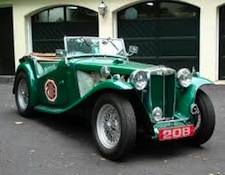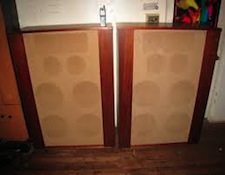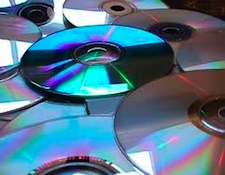It’s the time of year for saving money!

I remember, when I was a little kid, being given a ride in a
British Racing Green 1948 MGTC roadster owned by one of my parents’ friends. It
was thrilling and it was gorgeous and, that very day, I started saving whatever
small amounts I could from my allowance in hopes that I would eventually be
able to buy one of my own.
A similar thing happened in 1951, when the owner of a nearby
gas station bought a brand new black Jaguar Mark V Saloon. That became my new
standard of automotive beauty and, like the “TC”, I vowed with all my then
nine-year-old heart that someday I, too, would own one.

I’ve had the same kinds of experiences with audio gear: The
very first high fidelity speaker system I ever heard was a Bozak B-310a ― a refrigerator-sized
thirteen-driver behemoth that made real 24 Hz bass even in the middle of the
last century and was pretty enough to sleep with. It was powered by a McIntosh
60 Watt amplifier, another wonder and glory for its day, and hearing them play
pipe organ – even in mono — was enough to curl my twelve-year-old toes and
make me an audiophile for life.
It wasn’t just those classics that got me, either, there were
all the other great McIntosh, Marantz and other tube gear, and there were the
horns: the Klipschorn, the Electro-Voice Patrician, and the James B. Lansing
(now “JBL”) Hartsfield for home use; the Altec recording studio monitors; and
the massive Western Electric and RCA theater systems for the movies. I even got
into recording, and when RCA closed down their Sycamore street recording
studios in Hollywood, I bought a pair of their legendary 44bx ribbon
microphones (the ones that the famous Frank Sinatra caricature was modeled
after) for the princely (to a kid my age) sum of $50 each.
I’m not the only one to fall in love with those ancient
wonders. Like classic cars, classic audio gear and even classic-inspired audio gear have a solid and
growing fan following, and the market value – at least of the genuine articles
— seems to be increasing almost exponentially.
Although the transistor boom in the late 1950s and early ’60s
was feared to mark the doom of vacuum tube electronics; the “perfect sound
forever” of the CD was supposed to do the same for LPs in 1982; and new
techniques to make more bass from smaller, cheaper, more “Wife Acceptable”
speakers promised to make the giant horns and infinite baffles of earlier times
go away, none of that has happened. Horns and other massive classic or
classic-style speakers are once again proliferating; phonograph records and
their associated playback equipment are enjoying a real renaissance; and,
although I did no actual counting, tube electronics seemed, at the recent 2013
Newport Audio Show, to have its solid-state competition solidly outnumbered.
But why?

No one can deny that the MGTC and the Jaguar Mark V Saloon –
those old cars that so moved me, really were classics. Even now, well more than
a half century later, many regard them as among the all-time greats and see
them as both a triumph of early postwar automotive design and as the last, and
perhaps best, bloom of a whole way of thinking about how a car should look.
Inspiringly beautiful though they were, however, neither I nor anyone else
could ever call either of them – except perhaps for their own era – any kind of
great performer. By modern standards, both were slow in top-end, lacking in
acceleration and braking, and, at best, undistinguished in their handling —
hardly the kind of cars that, like a Mini-Cooper, a Lotus Seven, or even the
best of today’s sedans, you would want to throw around corners or even drive at
any particularly brisk pace.
The fact of the matter is that modern cars are simply a whole
lot better and, in their own way, many are just as beautiful. Does the same hold true for audio?
The classic audio designs are certainly beautiful and a great
many people certainly like and are willing to pay for the way they sound, but
how do they rate in terms of real performance? Are they as good as modern
designs?

To answer that poses not just one, but two real problems: The first is to try to come up with some
universally acceptable standard of “better” as it applies to music and the
playback of recorded sound. With cars,
that’s easy: Performance standards can be specifically defined and the degree
to which they are achieved in terms of top speed or cornering g-force, or speed
around a track can be accurately measured and everyone will agree on the
findings. With audio, though, where the
most significant factors are subjective and the measured differences between
what is subjectively great and what is subjectively unacceptable may be tiny,
how can you do that? How can you even define which standards to measure
against? The last decades of open warfare between the “subjectivists” and
“objectivists,” doesn’t make it look easy.
And even if “better” could be defined and a “better-ness”
standard set in place that would satisfy everyone, what would it show?
The second problem regards the very idea of “progress”. If
classic designs, like horns and Williamson-or-other-classic-circuit tube
amplifiers, and vinyl or tape analogue playback formats and equipment are
proven really to be better, as the classic-lovers insist them to be, what does
that say about all of our so-called “progress” in the last sixty years since
the mid-1950s? And if they AREN’T better under our new definition should
somebody tell that to all those people who own and love and have paid good
money for their classic gear?
Personally, I think the whole issue is bogus. I still want a
“TC” or a “Mark V”, regardless of how it stacks-up against more modern
cars. What they do best – winning the
hearts of their owners, and maybe some smiles from the ladies – no modern car
can match. (And if it can, I want one of those, too!)
It’s the same thing for audio. I have solid-state and
electrostatics for one kind of enjoyment. For another I have analog, tubes, and
my lovely, albeit modern, horns. They not only sound great and are
BLOW-YOUR-HEAD-OFF dynamic, they even create a believable image!
Problem solved?





